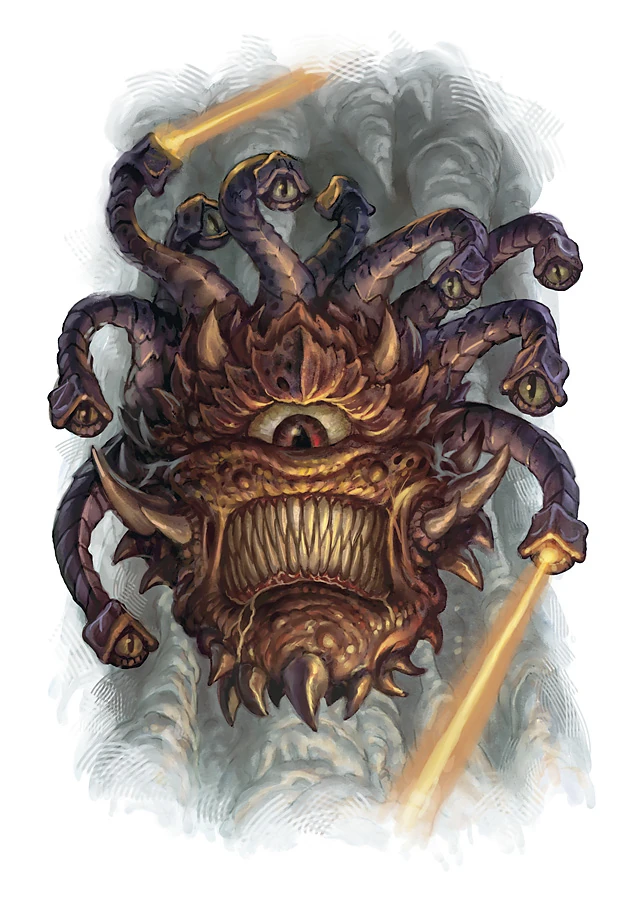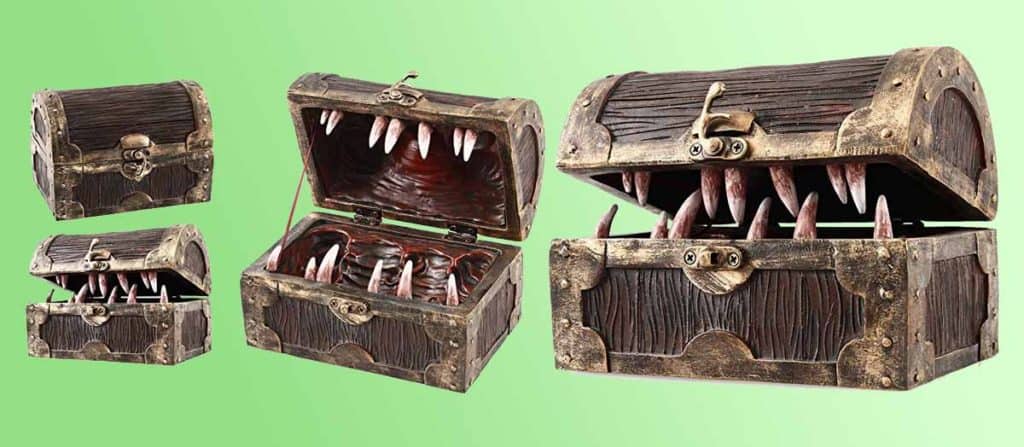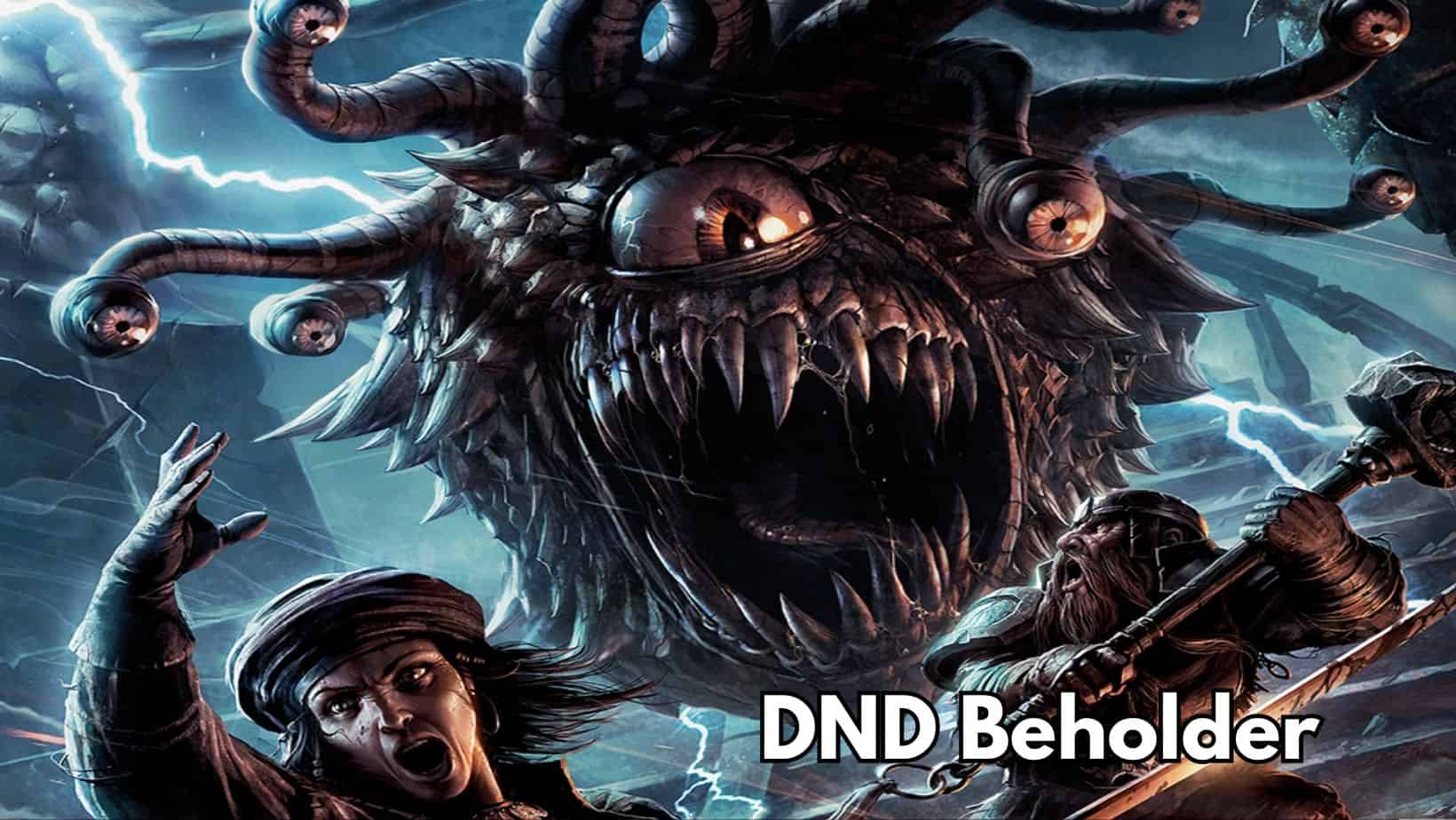The Dungeons & Dragons universe is teeming with fascinating creatures, but few are as iconic or as terrifying as the Beholder. This aberration, a grotesque floating sphere covered in eyes, has captivated – and horrified – players of the beloved tabletop RPG for decades. Known for its potent magical abilities and its relentlessly xenophobic temperament, the Beholder stands as a testament to the brilliant, often twisted creativity that defines Dungeons & Dragons.
Resembling a monstrous floating eyeball flanked with multiple eye-stalks, each with its own magical capability, the Beholder is a truly nightmarish creature. Inspired by the surreal imaginations of the early D&D creators, their unique design sets them apart in the diverse bestiary of the D&D universe. For those unfortunate enough to cross paths with a Beholder, they often find it an encounter to vividly remember – if they survive it.
The D&D universe is rich and varied, offering vast opportunities for storytelling, perilous adventures, and heroic deeds. Amidst this backdrop, the Beholder has garnered a reputation as an adversary not to be taken lightly. Each Beholder sees itself as the epitome of perfection, despising anything unlike itself and resorting to violence swiftly and mercilessly. This ruthless attitude coupled with powerful magic and formidable defenses make Beholders a challenge for even seasoned adventurers.
In this guide, we’ll delve deeper into the lore, anatomy, various powers, and abilities of the Beholders, and explore their many variants. Additionally, we’ll provide tips for Dungeon Masters on how to successfully incorporate Beholders into gameplay, and even advise on crafting your very own Beholder for a truly unique campaign experience. Whether you’re a veteran player or new to the D&D realm, this guide aims to enhance your understanding of one of the game’s most monstrous and iconic creatures. Hold onto your dice – it’s time to face the Beholder.
- The Origin of the Beholder
- Anatomy of a Beholder
- Powers and Abilities
- Beholder Variants
- Encountering a Beholder in Gameplay
- The Beholder in Pop Culture
- Creating Your Own Beholder
- Frequently Asked Questions (FAQs)
- What does the Beholder do in Dungeons & Dragons?
- What is a Beholder’s weakness?
- What is the most powerful Beholder?
- What kills a Beholder?
- What are Beholders afraid of?
- What do Beholders hate?
- At what level should you fight a Beholder?
- Can you tame a Beholder?
- What monsters go well with Beholders?
- Do people know Xanathar is a Beholder?
- Is a Beholder stronger than a Dragon?
- What happens if two Beholders look at each other?
- Conclusion: Dungeons and Dragons Beholder
The Origin of the Beholder
The terrifying Beholder made its first appearance in the Greyhawk supplement for the original Dungeons & Dragons game, way back in 1975. It was crafted by Terry Kuntz, who played in Gary Gygax’s original Greyhawk campaign, and the creature was then further developed by future Dungeons & Dragons designers.
In the lore, Beholders are alien beings, often thought to originate from a plane of existence beyond the normal realms of fantasy space and time. Their alien nature is echoed in their horrifyingly unique physical form and in their complex, unpredictable, and unfathomable psychologies.
Try my AI Tabletop RPG generators...and an extensive library of content!
Over the years, the Beholder has rightfully earned its place as a classic icon within the Dungeons & Dragons franchise. It has evolved through the various editions of the game, with its core fearsome concept remaining largely intact, even as new varieties have emerged and their powers have been tweaked to fit the evolving game mechanics.
Anatomy of a Beholder

The physical form of a Beholder is enough to paralyse many an adventurer with pure dread. Imagine a massive, levitating spheroid, as wide as a tall man is high. The creature’s body is dominated by a single, monstrous eye, which glares from the middle of the hulking orb. This central eye emits an anti-magic field, a unique ability that makes the Beholder an especially terrifying opponent for spell-casting foes.
Radiating from around the central body are numerous (typically ten) smaller eye stalks, each ending in an eye that houses its own dreadful magical beam, capable of causing effects ranging from petrifaction and sleep to death or disintegration.
The Beholder’s mouth is a wide, gaping maw filled with sharp, dagger-like teeth. Flexible and dexterous, it can eat, speak, and issue a terrifying roar that shakes the very air. The creature’s skin is tough and rugged, usually of darker shades ranging from brown to deep violet, providing a significant natural armour against attacks.
⚔️ Fantasy RPG Random Tables Books
Make life as a Gamemaster easier…
If you play Dungeons & Dragons, Pathfinder, or other fantasy RPGs, this
RPG random tables series
is packed with encounters, NPCs, treasure, and more. Available in eBook or print—either way, you’ll have a wealth of adventure ideas at your fingertips.
The Beholder is a biological oddity – it has no discernible organs or anatomy as understood by most races, and the precise workings of its levitation, its eye-beams, and its seemingly digestion-based reproduction continue to baffle many in-universe sages. One thing, however, is clear: a Beholder is a creature of raw, terrifying power, a nightmarish juggernaut of bizarre magic and ferocious predation.
Powers and Abilities
Beholders are potent magical creatures, each of their eyes housing destructive and controlling abilities. The large central eye projects a cone of anti-magic. Essentially, anything falling within the gaze of the central eye finds itself stripped of magical properties. This means spells, magical weapons, and supernatural abilities of magical creatures cease to function under the influence of this gaze. The Beholder, however, is especially crafty. By squinting, or even fully closing its central eye, it can allow its own magical eye beams to function while still keeping its enemies suppressed.
Each of the Beholder’s smaller eyes produce a different “eye-beam”, a magical ray that can generate a variety of effects. The exact powers of these eye-beams have varied across different editions of D&D, but they generally include abilities such as causing fear, charming or dominating individuals, inflicting serious wounds, causing paralysis, petrification, disintegration, sleep, and slow, among others. Some can even straight-up kill an adversary. It’s this horrifying array of magical powers that makes encounters with Beholders memorable – and deadly.
Beholder Variants
As bizarre and terrible as the classic Beholder is, there are many other variants that exhibit their own unique twists on the Beholder form. These different types of Beholders are often featured in various editions of D&D:
Death Tyrants are undead variations of the Beholder. They look like ghostly, skeletal Beholders. Their eye beams can produce powerful necrotic effects.
Spectators are a smaller, less harmful form of Beholder, often summoned to guard treasures or locations.
Gauths are a somewhat weaker variant that feed on magic and often mistaken for true Beholders. They’re infamous for their magical eye-beams and four long tentacles.
Elder Orbs are older, more powerful Beholders who exhibit stronger magical abilities and have lived long enough to gain considerable wisdom and knowledge.
Eye of Shadows are Beholders tainted by the Shadowfell, marked by a darkness that consumes their body and a cruel, nihilistic outlook on life.
Hive Mothers are rare, powerful Beholders that can control others of their kind. They’re usually the apex of a Beholder community, exerting strong influence and coordination – a rare trait among the typically solitary Beholders.
Each variant of the Beholder brings its unique abilities, making them a fascinating (and dangerous) challenge in any D&D campaign. Whether you’re facing the raw destructive power of the Death Tyrants or the insidious magical theft of the Gauths, Beholders are an engaging, versatile foe that can add an unforgettable layer of horror and intrigue to your D&D adventures.

Encountering a Beholder in Gameplay
When a Dungeon Master decides to introduce a Beholder into a campaign, they’re infusing their game with a potent adversary that demands clever strategies from the players. Beholders aren’t simply monstrous powerhouses to throw against a party; their innate paranoia, strategic cunning, and unusual powers make for a complex and challenging foe.
One of the most effective strategies for incorporating a Beholder into your campaign is to emphasize its unique traits and abilities. Use its anti-magic eye to disrupt the spells of the party’s magic-users, turn its eye-beams not just into simple attacks, but strategic tools – petrifying the group’s sturdy front liners with its Petrification Ray, sending the rogues to sleep in mid-step with a Sleep Ray, or even causing intra-group conflict with a Charm Ray.
In terms of encounter scenarios, creating lairs with numerous vertical shafts plays to the Beholder’s flying advantage and disrupts conventional party formations. Think about the Beholder’s personality and motives while designing the encounter: maybe it’s the paranoid tyrant in a dungeon filled with traps and dominated minions, or an outcast studying arcane mysteries in a bizarre, otherworldly lair echoing with strange spells and populated by twisted experiments.
The Beholder in Pop Culture
The Beholder’s haunting visage and potent powers have helped it transcend the Dungeons & Dragons tabletop game, making appearances in a variety of pop culture mediums. It’s become an emblem of the game itself, appearing in many video games based on the D&D franchise, like the ‘Baldur’s Gate’ series, ‘Neverwinter Nights,’ and the MMORPG ‘Neverwinter.’
⚔️ Fantasy RPG Random Tables Books
Make life as a Gamemaster easier…
If you play Dungeons & Dragons, Pathfinder, or other fantasy RPGs, this
RPG random tables series
is packed with encounters, NPCs, treasure, and more. Available in eBook or print—either way, you’ll have a wealth of adventure ideas at your fingertips.
But the Beholder’s influence goes beyond gaming. In literature, it plays prominent roles in several Forgotten Realms novels, including Ed Greenwood’s ‘Spellfire,’ where the protagonist squares off against a ruthless Beholder Mage. In modern media, it’s popped up surprisingly in shows like ‘Stranger Things,’ serving as a terrifying symbol of the Upside Down.
The Beholder’s influence has even reached the world of music, being featured in songs by metal bands like Gygax (named after D&D co-creator Gary Gygax), whose song “The Hunter’s Heart” is an homage to this iconic monster.
From a formidable adversary in a beloved table-top RPG to a recognizable symbol in pop culture, the Beholder truly stands as one of the most iconic and influential creatures in fantasy lore. Whether you’re battling one in a dungeon, encountering it in a video game, or spotting it in a favorite show, the Beholder continues to capture our imaginations with its unique blend of terror and fascination.
Creating Your Own Beholder
Crafting your own custom Beholder can add an exciting and unique challenge to your campaign. While traditional Beholders are terrifying enough, introducing players to a Beholder with unique abilities or behaviors can amplify the threat and introduce unexpected dynamics.
Start with a basic Beholder template, but consider modifying its spell list or even its eye ray capabilities, based on the unique persona or backstory you’ve crafted. Perhaps your Beholder is obsessed with time manipulation and its eye rays include novel mechanics centered on speeding up, slowing, or even reversing time.
Behavioral tweaks can be just as impactful. What if your Beholder is ruthlessly intelligent and loves to throw riddles and puzzles at adventurers before engaging in combat? Maybe it has taken a peculiar fancy to collecting rare musical instruments, or it harbors a paranoid fear of mirrors! Remember, the possibilities are only limited by your imagination.
While creating a unique Beholder, always bear in mind the balance of the game. Each modification should offer an intriguing challenge, but not be overwhelming or utterly unbeatable for your player party.
Frequently Asked Questions (FAQs)
For those of you curious adventurers or meticulous dungeon masters looking to dive headfirst into the world of Dungeons & Dragons, there’s a high chance you’ve come across or at least heard about the Beholders. Notorious for their potent magical abilities, these villains command fear and respect in equal measure, often serving as dramatic climaxes in numerous campaigns. To help you navigate your encounters with these fascinating yet formidable foes, here are detailed answers to some of the most frequently asked questions about Beholders.
What does the Beholder do in Dungeons & Dragons?
In the all-encompassing realm of Dungeons & Dragons, Beholders are feared adversaries lauded for their potent magical abilities. The primary power of Beholders lies in their numerous eyes, each capable of emitting unique magical eye-beams, which can cast a myriad of destructive spells. Additionally, a Beholder’s central eye is famed for its capacity to nullify magic in its vicinity, rendering opponents’ spells useless and tipping the balance of power in favor of these awe-inspiring creatures. Averse to direct physical confrontation, these creatures tend to keep foes at bay, leveraging their magic to wage battles from a distance.
What is a Beholder’s weakness?
Despite their legendary status and formidable magical abilities, Beholders are not invincible. They are physically weaker compared to other creatures, making them vulnerable to direct physical attacks, especially when they’re caught off guard. In addition to their physical shortcomings, Beholders are notoriously paranoid and obsess over details and their perceived perfection. A crafty adventurer can exploit these psychological quirks to gain an upper hand in confrontations with these otherwise daunting opponents.
What is the most powerful Beholder?
Determining the most potent Beholder can be subjective due to the diverse interpretations across various editions and settings of Dungeons & Dragons. That being said, one name that frequently arises in such debates is Xanathar. This infamous Beholder, residing in the sprawling cityscape of Waterdeep in the Forgotten Realms, has left an indelible imprint in the collective memory of adventurers due to his immense power and infamous reputation. However, there could be multiple other formidable Beholders prowling and plotting in the shadowy corners of multiverse, still undiscovered and waiting to challenge brave adventurers.
What kills a Beholder?
Although Beholders are formidable opponents, they aren’t impervious to demise. These creatures can be killed through relentless physical combat, or through tactfully evading their central eye’s anti-magic cone while casting spells. Moreover, due to their inherent paranoia and obsession with perfection, they can sometimes be manipulated or trapped into unfavorable situations, which can be exploited to vanquish them. A successful strategy often requires a combination of battle prowess, witty thinking, and insightful understanding of Beholder’s psychology.
What are Beholders afraid of?
Riddled with notorious paranoia and an overwhelming obsession with supremacy and perfection, Beholders do have their own set of fears. Foremost among these concerns are other Beholders. As each Beholder considers itself to be the epitome of perfection, the mere sight of another Beholder, with even minute differences, can instill fear and enmity in it. Additionally, they also fear powerful adventurers and any entities that pose a firm threat to their supremacy or malign their perceived ideal physical form.
What do Beholders hate?
Much like their fears, Beholder’s hatred centers around themes of imperfection, competition, and defiance. They detest anything that falls short of their personal standards of perfection. Their intense xenophobia is especially pronounced towards other Beholders, which they see as distorted versions of their ideal form. Any entity that dares to challenge or defy them also earns their wrath, fueling their thirst for supremacy and control.
Try my AI Tabletop RPG generators...and an extensive library of content!
At what level should you fight a Beholder?
Beholder encounters are considered high-level challenges, typically suitable for characters who already fall within or exceed the level 13 mark. However, the difficulty level and appropriateness of a Beholder encounter could vary widely, depending on the discretion of the Dungeon Master and the specific type of Beholder implemented. As these creatures possess an array of potent abilities and an innate knack for strategy, they make for an impressive adversary that necessitates clever tactics and robust teamwork.
Can you tame a Beholder?
Taming a Beholder is an endeavor that often borders on the impossible. Their inherently chaotic and self-obsessed nature makes it extremely difficult, if not completely unfeasible, to coerce them into obedience. While crafty role-playing or exceptional circumstances might enable limited and often temporary cooperation, don’t bank on achieving a truly tamed or domesticated Beholder as one would with more standard creatures.
What monsters go well with Beholders?
Being a creature of the Underdark, Beholders can be found in the company of various minions that they have subjugated or who fear them, like Goblins, Mind Flayers, or other Underdark denizens. This combination of creatures complements the Beholder’s deadly magical abilities with more physical or psychic threats, heightening the danger for any adventurers brave enough to confront them. However, the mix of creatures can vary widely, adding an unpredictability to their encounters.
Do people know Xanathar is a Beholder?
The true identity of Xanathar as a Beholder remains a well-guarded secret, known only to an exclusive circle in the criminal underworld, and perhaps to those unfortunate enough to directly encounter him. His reputation as the leader of a powerful thieves’ guild has allowed him to preserve his clandestine persona. As such, the common folk of Waterdeep, where he most notably operates, are unaware about his monstrous true form, allowing Xanathar to operate from the shadows, exerting influence while maintaining a veil of relative anonymity.
Is a Beholder stronger than a Dragon?
To compare the strengths of a Beholder and a Dragon involves a careful examination of their unique abilities and assets. A Beholder’s arsenal boasts of potent magical abilities and eye rays that that can cause sizeable damage and control over battles. On the other hand, Dragons bring to the fray their incredible physical strength, their own brand of powerful magic, and the added dynamic of flight. As such, the outcome of an encounter between a Dragon and a Beholder would likely center on strategic application of abilities, the environment and the specificities of the creatures involved, rather than just comparing raw power.
What happens if two Beholders look at each other?
When two Beholders come face-to-face, the encounter often devolves into a full-scale battle rooted in their inherent xenophobic hatred for each other. Using their versatile range of eye-ray abilities, the Beholders engage in a high-stakes contest of powerful spells and meticulously planned strategy. Rarely does such an encounter end without a dramatic and explosive conclusion, as it’s highly unlikely for these narcissistic creatures to settle their differences peacefully. An eyewitness to a duel between Beholders would indeed have a terrifying tale to tell.
Conclusion: Dungeons and Dragons Beholder
The Beholder is much more than a floating mass of eyes; it’s an iconic entity that embodies the fantastic and bizarre creativity of Dungeons & Dragons. From the lore surrounding its alien origins to its terrifying anatomy and deadly abilities, the Beholder is justifiably one of the most recognized monsters in the D&D universe.
As we’ve explored, the Beholder fuels thrilling gameplay with its multifaceted eye rays, distinctive anti-magic field, and the sheer unpredictability it brings to encounters. Crafting your own unique Beholder, imbuing it with novel quirks and abilities, can add an element of surprise and challenge to any campaign.
We hope this deep dive into the world of Beholders has armed you with a treasure hoard of knowledge, whether you’re a Dungeon Master planning your next campaign or a valiant adventurer steeling yourself for an encounter with the dreaded eye tyrant. If you’ve had any experiences with Beholders you’d like to share, or if you’ve concocted your own unique variant, we’d love to hear about it in the comments. May your dice roll ever in your favor!
⚔️ Fantasy RPG Random Tables Books
Make life as a Gamemaster easier…
If you play Dungeons & Dragons, Pathfinder, or other fantasy RPGs, this
RPG random tables series
is packed with encounters, NPCs, treasure, and more. Available in eBook or print—either way, you’ll have a wealth of adventure ideas at your fingertips.










